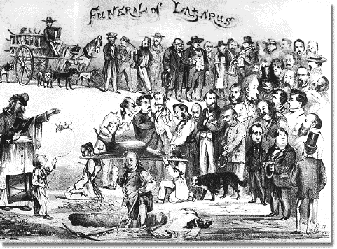Bummer and Lazarus
Bummer and Lazarus were two stray dogs that roamed the streets of San Francisco between 1861 and 1865. They became famous for their expertise at killing the rats that infested the city in those days, and for their unique bond of friendship. Newspapers vied with each other in reporting their escapades, whether it was stealing a bone from another dog, getting locked overnight inside a jewelry store, or stopping a runaway horse and cart on Clay Street. On June 16, 1862, the San Francisco Board of Supervisors exempted them from a strict ordinance that banned all dogs downtown without a leash and/or muzzle, and allowed them to roam, unfettered, wherever they wished.
Edward Jump, a young French artist, included the two dogs in a series of satirical cartoons lampooning the city's notable characters, one of whom was Joshua Abraham Norton, who proclaimed himself Emperor Norton I of the United States and Mexico in 1859. These cartoons later led to the myth that Bummer and Lazarus were Norton's pets, even though no contemporary account made such a connection.
When Lazarus died in October 1863, the Daily Evening Bulletin ran a lengthy obituary entitled "Lament for Lazarus." Bummer died a painful and lingering death two years later after being savagely kicked by a drunk. Mark Twain, then a young reporter for the Virginia City (Nevada) Territorial Enterprise, wrote a characteristically wry obituary in which he said that Bummer had died "full of years, and honor, and disease, and fleas." The Bulletin referred to them as "two dogs with but a single bark, two tails that wagged as one."
Image: Virtual Museum of San Francisco
Cartoonist Edward Jump's famous picture, from the Wasp, shows Norton I as the pope, performing the funeral service for Lazarus. The crowd is composed of well-known San Franciscans of the era. Bummer and Lazarus were mongrel dogs – the supposed pets of Norton I.
The skins of both dogs were stuffed by a taxidermist and placed on display in the two saloons they had frequented while alive. In 1906 the skins were given to the Golden Gate Park Museum (now the M.H. de Young Memorial Museum) for display. They remained in storage there until 1910, when they were destroyed.
On March 28, 1992, a 30" x 20" brass plaque recalling their adventures and misadventures was installed at the base of one of the city's most visible landmarks, the Transamerica Pyramid.
--Malcolm E. Barker
Bibliography
Anne Bancroft: The Memorable Lives of Bummer & Lazarus (Citizens of San Francisco). (Ward Ritchie Press, Los Angeles, 1934)
Malcolm E. Barker: Bummer & Lazarus: San Francisco's Famous Dogs (Londonborn Publications, San Francisco, 1984 and 2001)

